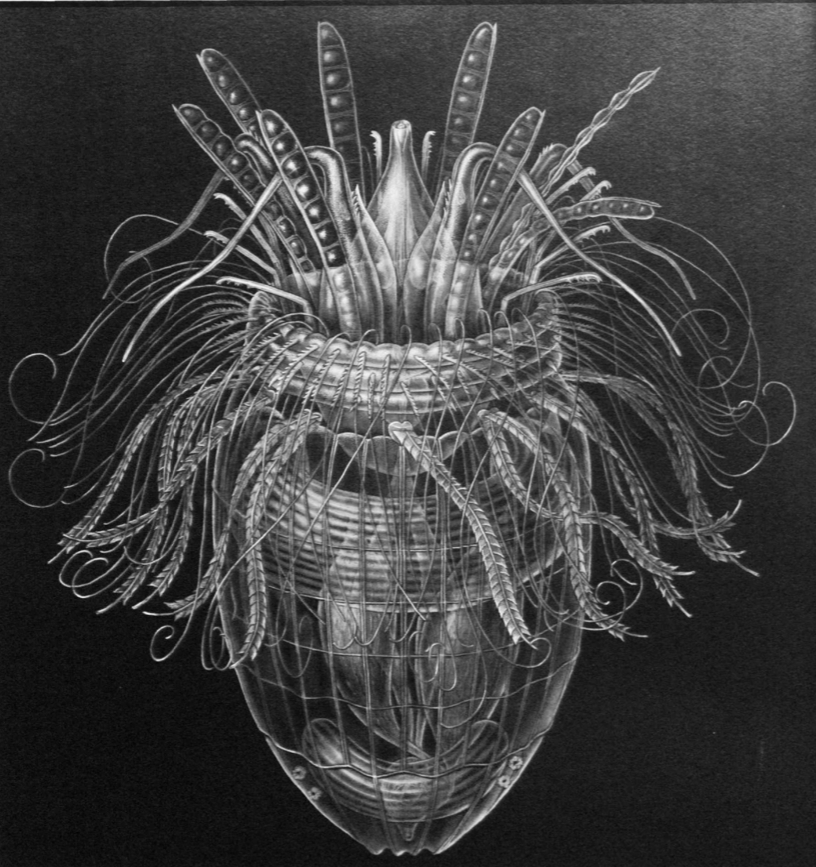| Topic: Earth's timeline being questioned | |
|---|---|
|
Fossil Discoveries Challenge Ideas About Earth’s Start
By Rebecca Boyle January 22, 2018 A series of fossil finds suggests that life on Earth started earlier than anyone thought, calling into question a widely held theory of the solar system’s beginnings. 5 How the young Earth might have looked during the Late Heavy Bombardment. How the young Earth might have looked during the Late Heavy Bombardment. NASA’s Goddard Space Flight Center In the arid, sun-soaked northwest corner of Australia, along the Tropic of Capricorn, the oldest face of Earth is exposed to the sky. Drive through the northern outback for a while, south of Port Hedlund on the coast, and you will come upon hills softened by time. They are part of a region called the Pilbara Craton, which formed about 3.5 billion years ago, when Earth was in its youth. Look closer. From a seam in one of these hills, a jumble of ancient, orange-Creamsicle rock spills forth: a deposit called the Apex Chert. Within this rock, viewable only through a microscope, there are tiny tubes. Some look like petroglyphs depicting a tornado; others resemble flattened worms. They are among the most controversial rock samples ever collected on this planet, and they might represent some of the oldest forms of life ever found. Last month, researchers lobbed another salvo in the decades-long debate about the nature of these forms. They are indeed fossil life, and they date to 3.465 billion years ago, according to John Valley, a geochemist at the University of Wisconsin. If Valley and his team are right, the fossils imply that life diversified remarkably early in the planet’s tumultuous youth. A sliver of a nearly 3.5-billion-year-old rock from the Apex Chert deposit in Western Australia (top). An example of one of the microfossils discovered in a sample of rock from the Apex Chert (bottom). A sliver of a nearly 3.5-billion-year-old rock from the Apex Chert deposit in Western Australia (top). An example of one of the microfossils discovered in a sample of rock from the Apex Chert (bottom). Jeff Miller (Epoxy mount); Courtesy of J. William Schopf, UCLA (microfossil) The fossils add to a wave of discoveries that point to a new story of ancient Earth. In the past year, separate teams of researchers have dug up, pulverized and laser-blasted pieces of rock that may contain life dating to 3.7, 3.95 and maybe even 4.28 billion years ago. All of these microfossils — or the chemical evidence associated with them — are hotly debated. But they all cast doubt on the traditional tale. As that story goes, in the half-billion years after it formed, Earth was hellish and hot. The infant world would have been rent by volcanism and bombarded by other planetary crumbs, making for an environment so horrible, and so inhospitable to life, that the geologic era is named the Hadean, for the Greek underworld. Not until a particularly violent asteroid barrage ended some 3.8 billion years ago could life have evolved. But this story is increasingly under fire. Many geologists now think Earth may have been tepid and watery from the outset. The oldest rocks in the record suggest parts of the planet’s crust had cooled and solidified by 4.4 billion years ago. Oxygen in those ancient rocks suggest the planet had water as far back as 4.3 billion years ago. And instead of an epochal, final bombardment, meteorite strikes might have slowly tapered off as the solar system settled into its current configuration. “Things were actually looking a lot more like the modern world, in some respects, early on. There was water, potentially some stable crust. It’s not completely out of the question that there would have been a habitable world and life of some kind,” said Elizabeth Bell, a geochemist at the University of California, Los Angeles. Taken together, the latest evidence from the ancient Earth and from the moon is painting a picture of a very different Hadean Earth: a stoutly solid, temperate, meteorite-clear and watery world, an Eden from the very beginning. More here |
|
|
|
|
|
Primordial oceans had oxygen 250 million years before the atmosphere
http://www.sciencedaily.com/releases/2018/01/180125101329.htm Date: January 25, 2018 Source: University of Minnesota Summary: New research has pushed a major milestone in the evolution of Earth's environment back by about 250 million years. "We've resolved some puzzles in the historical timeline and contradictions that existed in the sulfur isotope records," said Fakhraee. Research by a University of Minnesota Duluth (UMD) graduate student Mojtaba Fakhraee and Associate Professor Sergei Katsev has pushed a major milestone in the evolution of Earth's environment back by about 250 million years. While oxygen is believed to have first accumulated in Earth's atmosphere around 2.45 billion years ago, new research shows that oceans contained plentiful oxygen long before that time, providing energy-rich habitat for early life. The results of the two UMD scientists and their co-author Sean Crowe from the University of British Columbia have been published in the peer-reviewed journal Science Advances. http://earthdevelopslife.blogspot.com/ 4,573,000,000 Positive identification of living extraterrestrial bacteria entering the Earth's upper atmosphere from space came in 2001. Panspermia no longer a theory. Daily, the earth receives more than 600 pounds of biological material from space. 4,444,000,000 Earth's atmosphere is mostly water vapor with methane, carbon dioxide, ammonia, and hydrogen Great Oxygenation Event https://en.wikipedia.org/wiki/Great_Oxygenation_Event Free oxygen is toxic to obligate anaerobic organisms, and the rising concentrations may have destroyed most such organisms at the time. Cyanobacteria were therefore responsible for one of the most significant mass extinctions in Earth's history. Besides marine cyanobacteria, there is also evidence of cyanobacteria on land. |
|
|
|
|
|
Primordial oceans had oxygen 250 million years before the atmosphere http://www.sciencedaily.com/releases/2018/01/180125101329.htm Date: January 25, 2018 Source: University of Minnesota Summary: New research has pushed a major milestone in the evolution of Earth's environment back by about 250 million years. "We've resolved some puzzles in the historical timeline and contradictions that existed in the sulfur isotope records," said Fakhraee. Research by a University of Minnesota Duluth (UMD) graduate student Mojtaba Fakhraee and Associate Professor Sergei Katsev has pushed a major milestone in the evolution of Earth's environment back by about 250 million years. While oxygen is believed to have first accumulated in Earth's atmosphere around 2.45 billion years ago, new research shows that oceans contained plentiful oxygen long before that time, providing energy-rich habitat for early life. The results of the two UMD scientists and their co-author Sean Crowe from the University of British Columbia have been published in the peer-reviewed journal Science Advances. http://earthdevelopslife.blogspot.com/ 4,573,000,000 Positive identification of living extraterrestrial bacteria entering the Earth's upper atmosphere from space came in 2001. Panspermia no longer a theory. Daily, the earth receives more than 600 pounds of biological material from space. 4,444,000,000 Earth's atmosphere is mostly water vapor with methane, carbon dioxide, ammonia, and hydrogen Great Oxygenation Event https://en.wikipedia.org/wiki/Great_Oxygenation_Event Free oxygen is toxic to obligate anaerobic organisms, and the rising concentrations may have destroyed most such organisms at the time. Cyanobacteria were therefore responsible for one of the most significant mass extinctions in Earth's history. Besides marine cyanobacteria, there is also evidence of cyanobacteria on land. |
|
|
|
|
|
Primordial oceans had oxygen 250 million years before the atmosphere http://www.sciencedaily.com/releases/2018/01/180125101329.htm Date: January 25, 2018 Source: University of Minnesota Summary: New research has pushed a major milestone in the evolution of Earth's environment back by about 250 million years. "We've resolved some puzzles in the historical timeline and contradictions that existed in the sulfur isotope records," said Fakhraee. Research by a University of Minnesota Duluth (UMD) graduate student Mojtaba Fakhraee and Associate Professor Sergei Katsev has pushed a major milestone in the evolution of Earth's environment back by about 250 million years. While oxygen is believed to have first accumulated in Earth's atmosphere around 2.45 billion years ago, new research shows that oceans contained plentiful oxygen long before that time, providing energy-rich habitat for early life. The results of the two UMD scientists and their co-author Sean Crowe from the University of British Columbia have been published in the peer-reviewed journal Science Advances. http://earthdevelopslife.blogspot.com/ 4,573,000,000 Positive identification of living extraterrestrial bacteria entering the Earth's upper atmosphere from space came in 2001. Panspermia no longer a theory. Daily, the earth receives more than 600 pounds of biological material from space. 4,444,000,000 Earth's atmosphere is mostly water vapor with methane, carbon dioxide, ammonia, and hydrogen Great Oxygenation Event https://en.wikipedia.org/wiki/Great_Oxygenation_Event Free oxygen is toxic to obligate anaerobic organisms, and the rising concentrations may have destroyed most such organisms at the time. Cyanobacteria were therefore responsible for one of the most significant mass extinctions in Earth's history. Besides marine cyanobacteria, there is also evidence of cyanobacteria on land. Yeah, I remember reading something about that too. What makes science interesting is that as we learn more about things we have to go back and revise to keep on track. Anyone interested in science has to be flexible, very flexible. |
|
|
|
|
|
Primordial oceans had oxygen 250 million years before the atmosphere http://www.sciencedaily.com/releases/2018/01/180125101329.htm Date: January 25, 2018 Source: University of Minnesota Summary: New research has pushed a major milestone in the evolution of Earth's environment back by about 250 million years. "We've resolved some puzzles in the historical timeline and contradictions that existed in the sulfur isotope records," said Fakhraee. Research by a University of Minnesota Duluth (UMD) graduate student Mojtaba Fakhraee and Associate Professor Sergei Katsev has pushed a major milestone in the evolution of Earth's environment back by about 250 million years. While oxygen is believed to have first accumulated in Earth's atmosphere around 2.45 billion years ago, new research shows that oceans contained plentiful oxygen long before that time, providing energy-rich habitat for early life. The results of the two UMD scientists and their co-author Sean Crowe from the University of British Columbia have been published in the peer-reviewed journal Science Advances. http://earthdevelopslife.blogspot.com/ 4,573,000,000 Positive identification of living extraterrestrial bacteria entering the Earth's upper atmosphere from space came in 2001. Panspermia no longer a theory. Daily, the earth receives more than 600 pounds of biological material from space. 4,444,000,000 Earth's atmosphere is mostly water vapor with methane, carbon dioxide, ammonia, and hydrogen Great Oxygenation Event https://en.wikipedia.org/wiki/Great_Oxygenation_Event Free oxygen is toxic to obligate anaerobic organisms, and the rising concentrations may have destroyed most such organisms at the time. Cyanobacteria were therefore responsible for one of the most significant mass extinctions in Earth's history. Besides marine cyanobacteria, there is also evidence of cyanobacteria on land. Yeah, I remember reading something about that too. What makes science interesting is that as we learn more about things we have to go back and revise to keep on track. Anyone interested in science has to be flexible, very flexible. |
|
|
|
|
|
I wonder if the planet that hit the earth was a water world? The moon has some water on it, and the Earth could sucked most the water back down here...
|
|
|
|
|
|
Edited by
Tom4Uhere
on
Wed 01/31/18 09:35 AM
|
|
|
The Theia and Earth collision must have been a sight to see.
At some point in the process there must have been vast oceans floating in orbit. 
|
|
|
|
|
|
The Theia and Earth collision must have been a sight to see. At some point in the process there must have been vast oceans floating in orbit.  |
|
|
|
|
|
Could be?
Without referencing, just of memory here's my take on what happened. In this relatively close proximity in space there was a star that existed during the earlier time of the universe. Lets say 8 billion years ago. This was a massive high temperature star that only existed for around 3 or 4 billion years before it super-nova. In that star, it created elements which included gold, silver, oxygen, helium and hydrogen. When it exploded. Those elements were dispersed in clumps in this general vicinity of the Orion's Arm. Over hundreds of millions of years, these elements coalesced and formed a mass where our Sun now sits. As gravity started pulling together the clumps they hit the center at differing angles which initiated a spin to the cloud. As more material was gathered it gained higher and higher gravity attracting even more mass. Eventually, it reached a tipping point and ignited. That tipping point cause mass to be ejected into its orbit. The orbital masses then found gravity and started collecting at differing distances from the now new burning Sun. Planets started forming. The ejected material did not have enough mass to cause and ignition point and planets stabilized. There was still a lot of lighter elements in the cloud. These lighter element clustered together under gravity and became comets and asteroids. Science already knows that oxygen exists to this day in vast clouds near Jupiter-Saturn. Over time, as comets orbited the source Sun, they gathered oxygen and hydrogen from the solar cloud. They became coated with water ice. The early Earth experienced periods of orbital bombardment from many of these comets. As the comets impacted Earth, they deposited this water ice in great amounts. This orbital bombardment happened on every massive object in the system. At one point, another body collided with Earth and added its material makeup to Earth's. As the Earth cooled the elemental oxygen and hydrogen cooled and bonded to make water. Being in the Goldilocks zone, it remains liquid water. The total mass and makeup of the elements deposited here by the original star is super massive. Our entire solar system is basically composed of the dust from a dead star. That's a lot of stuff. The objects we 'see' in this solar system is only part of the total composition. There is still a lot of free range gas and dust that has not accumulated yet. So, the way I see it, Earth got its water from a dead star that exploded. |
|
|
|
|
|
Could be? Without referencing, just of memory here's my take on what happened. In this relatively close proximity in space there was a star that existed during the earlier time of the universe. Lets say 8 billion years ago. This was a massive high temperature star that only existed for around 3 or 4 billion years before it super-nova. In that star, it created elements which included gold, silver, oxygen, helium and hydrogen. When it exploded. Those elements were dispersed in clumps in this general vicinity of the Orion's Arm. Over hundreds of millions of years, these elements coalesced and formed a mass where our Sun now sits. As gravity started pulling together the clumps they hit the center at differing angles which initiated a spin to the cloud. As more material was gathered it gained higher and higher gravity attracting even more mass. Eventually, it reached a tipping point and ignited. That tipping point cause mass to be ejected into its orbit. The orbital masses then found gravity and started collecting at differing distances from the now new burning Sun. Planets started forming. The ejected material did not have enough mass to cause and ignition point and planets stabilized. There was still a lot of lighter elements in the cloud. These lighter element clustered together under gravity and became comets and asteroids. Science already knows that oxygen exists to this day in vast clouds near Jupiter-Saturn. Over time, as comets orbited the source Sun, they gathered oxygen and hydrogen from the solar cloud. They became coated with water ice. The early Earth experienced periods of orbital bombardment from many of these comets. As the comets impacted Earth, they deposited this water ice in great amounts. This orbital bombardment happened on every massive object in the system. At one point, another body collided with Earth and added its material makeup to Earth's. As the Earth cooled the elemental oxygen and hydrogen cooled and bonded to make water. Being in the Goldilocks zone, it remains liquid water. The total mass and makeup of the elements deposited here by the original star is super massive. Our entire solar system is basically composed of the dust from a dead star. That's a lot of stuff. The objects we 'see' in this solar system is only part of the total composition. There is still a lot of free range gas and dust that has not accumulated yet. So, the way I see it, Earth got its water from a dead star that exploded. |
|
|
|
|
|
Could be? Without referencing, just of memory here's my take on what happened. In this relatively close proximity in space there was a star that existed during the earlier time of the universe. Lets say 8 billion years ago. This was a massive high temperature star that only existed for around 3 or 4 billion years before it super-nova. In that star, it created elements which included gold, silver, oxygen, helium and hydrogen. When it exploded. Those elements were dispersed in clumps in this general vicinity of the Orion's Arm. Over hundreds of millions of years, these elements coalesced and formed a mass where our Sun now sits. As gravity started pulling together the clumps they hit the center at differing angles which initiated a spin to the cloud. As more material was gathered it gained higher and higher gravity attracting even more mass. Eventually, it reached a tipping point and ignited. That tipping point cause mass to be ejected into its orbit. The orbital masses then found gravity and started collecting at differing distances from the now new burning Sun. Planets started forming. The ejected material did not have enough mass to cause and ignition point and planets stabilized. There was still a lot of lighter elements in the cloud. These lighter element clustered together under gravity and became comets and asteroids. Science already knows that oxygen exists to this day in vast clouds near Jupiter-Saturn. Over time, as comets orbited the source Sun, they gathered oxygen and hydrogen from the solar cloud. They became coated with water ice. The early Earth experienced periods of orbital bombardment from many of these comets. As the comets impacted Earth, they deposited this water ice in great amounts. This orbital bombardment happened on every massive object in the system. At one point, another body collided with Earth and added its material makeup to Earth's. As the Earth cooled the elemental oxygen and hydrogen cooled and bonded to make water. Being in the Goldilocks zone, it remains liquid water. The total mass and makeup of the elements deposited here by the original star is super massive. Our entire solar system is basically composed of the dust from a dead star. That's a lot of stuff. The objects we 'see' in this solar system is only part of the total composition. There is still a lot of free range gas and dust that has not accumulated yet. So, the way I see it, Earth got its water from a dead star that exploded. For all intentions by perspective, it has always been here, in this star system. All I'm saying is that it was formed originally in a long dead star that gave this area of space the elements. Here's another thought I have been playing in my mind... Mars, at one time, had a water vapor atmosphere and vast oceans. Over time, being a smaller rocky planet it cooled and its liquid core started to harden. When that happened, its natural magnetosphere started to decay. The solar wind then blew its atmosphere off into space. As that happened the pressure dropped due to less atmosphere and the oceans of water evaporated and were also blown off into space. Then I read about the high amount of free oxygen clouds out near Jupiter/Saturn and figured that's where the water went. Cassini detected the water that was once Mars water. Its also likely that Jupiter's Ganymede ocean moon may have been coated with Martian water which, over time could have added to the moon's water volume. It might be possible that Ganymede could harbor life that was carried by the solar wind with Mars atmosphere. If our probes do penetrate Ganymede and find life, we will call it life on Ganymede but it may have originated on Mars. Ganymede also has a magnetosphere. Thus, any life that might occur there will be afforded some protection from solar radiation. On the flip-side, Its magnetosphere might have been present while Mars atmosphere was being carried by the solar wind and its magnetosphere could have been strong enough to deflect a large portion of the elements the solar wind was blowing. Its a toss up. We won't know till we drill the crust and take some samples and make some comparisons. Its a known fact that some particles do rain down onto Earth despite its magnetosphere. Same could be said for any celestial object with one. Its also a known fact that even Earth, with its magnetosphere out-gasses some of its atmosphere to space. So Earth also adds to the water content of the solar system. Once free-ranging, that water vapor is then propelled by the solar wind, outward. As comets and other debris passes thru these clouds the materials adhere to them. The build up over hundreds of millions of years until they impact a larger body. I imagine there is enough free water in the solar system to make another planet about the size of Neptune. But it is in elemental form and very, very cold. In about 5 or 6 billion years, when the Sun hits red giant stage, all the water on this planet will evaporate and be blown outward. Mars may be in liquid water temperature zone by then so oceans may form on its surface but without a magnetosphere and high pressure, it will also be blown outward. All the water from Earth will eventually be on or around the outer planets. What water that reaches the moons of the outer planets will fall as snow. Along with that snow will be microscopic forms of life and life components. Depending on the extent of the Sun's red giant properties there could be a short warming period at the outer planets. Not long enough for complex life to form but maybe long enough for simple anaerobic life to form. Then the red giant Sun will collapse into a white dwarf and the heat will dissipate. Ending that primitive life. During red giant phase, The Sun will sluff off its elements to the solar system. Since it won't super nova, there won't be a third generation star. Only a white dwarf system of cold elements. But, without the solar wind and the collapse of the heliosheath, those free ranging elements will be absorbed by inter stellar space and carried by that dynamic to other star systems. The elements that made up life here might find their way to a new system with a planet in liquid water range of its parent star and the process will repeat. Its called inter-stellar panspermia. This is my own take on it all. Its neither right or wrong, just a theory of my own. My views are taken from my own limited understanding based on things I have read. |
|
|
|
|
|
My personal opinion- I think they have it backwards... I think Venus was the first planet to support life here, before it went all hellish... I don't think Mars is big enough to ever have a thick enough atmosphere to support multi cell life forms...
|
|
|
|
|
|
Its possible Venus harbored life first.
I wouldn't say advanced life but life, indeed. There still may be Venusian life in the upper atmosphere. Way back when the Sun was young, its life range of temperature may have put Venus into the Goldilocks zone. Venus out-gasses too, it has an atmosphere. There's a possibility that life out-gassed from Venus and landed on Earth. Its difficult to picture the early solar system. Venus and Mars may have been in a very different state. Mars still has an atmosphere but its a very thin one. Ganymede may have a thin atmosphere as well. We know Titan has an atmosphere and it is not nearly as big or massive as Mars. While Mars mass may have limited its early atmosphere it is possible that while it had a magnetosphere protecting it from solar wind, it may have been substantial enough to allow liquid water to form oceans. There is evidence of past oceans on Mars in the geological structures we have recorded via probes. It all depends upon how long Mars was conducive to life? Over time, the planets spiral outward away from the Sun. The Sun is still not quite at its halfway life cycle of 12 billion years. Its still getting hotter. In the past, a cooler Sun with a less substantial solar wind and a freshly formed inner planet orbital path could have put Venus, Earth AND Mars within the Goldilocks Zone for a relatively short period (hundred million years or so). I don't know how long it takes for the elements of life to combine then form multi-cellular construction. Its possible that it happened on all three planets. We know that life does not require oxygen. There is still pockets of anaerobic life right now on Earth. One thing that always gets me is that most scientists claim that water is essential to life. However, Oxygen is poisonous to anaerobic life and water is made up of oxygen. There is proof right here on this planet that life does not require water. Anaerobic Marine Animals Loriciferans are a phylum of microscopic animals living between the particles of marine sediments.  In the classification of life there are two branches, aerobic and anaerobic. Much of the anaerobic life forms belong in the Archaea, specifically the Anaerobic Thermophillic Archaea. An early branch of the Eukaryota branch. The other branch, Bacteria, also has branches of anaerobic life. If both branches of the tree of life harbors strains of anaerobic life it could be said anaerobic life is common. Recently I read an article about how scientist found that meteorites harbor the building blocks of life. Ingredients for life revealed in meteorites that fell to Earth Study also suggests dwarf planet in asteroid belt may be a source of rich organic matter Date: January 10, 2018 Source: DOE/Lawrence Berkeley National Laboratory Summary: A detailed study of blue salt crystals found in two meteorites that crashed to Earth -- which included X-ray experiments found that they contain both liquid water and a mix of complex organic compounds including hydrocarbons and amino acids. Its been written that the early Earth was populated by anaerobic life first. That the process of iron oxidation was initiated by anaerobic life because that life process expels oxygen. Basically, the first mass extinction on this plane was when the anaerobic life forms poisoned themselves with their waste. Perhaps it is a normal process of mutation in the long process of planetary life. Anaerobic life, aerobic life, multi-cellular life, advanced multi-cellular life, intelligent life, next step unknown? |
|
|
|
|
|
Yea, I looked it up, Mars just a hair bigger than Titan, around 1600 miles diameter...
|
|
|
|
|
|
I'm not sure but I think I recall reading somewhere once that there is an asteroid that has an atmosphere? I do know that comets have out-gassing atmospheres.
I'm not sure what the mass cut-off is for atmosphere but they did detect an atmosphere on Pluto. It might be because its so far from the solar wind it can't be blown away but they said Pluto's atmosphere thickens and thins as it rotates or something? I understand that Earth and its proximity to the Sun would have its atmosphere blown off if not for our magnetosphere. But if Earth were moved to the orbit past Neptune, it might retain some of its atmosphere by gravity. It would be frozen but still exist in a primitive way. Thinking on this, I wonder what characteristics some of the outer gas giant moons might have at Earth's orbital location? As the Sun ages and gets hotter, Jupiter and Saturn's moons might become hostile conducive to life. Kinda like living in a dome in Antarctica. In a few billion years or so. Sun is 4.5 billion years old. Sun expected life span is 10 - 12 billion years. It is in the initial stages of main sequence right now and in a period of getting hotter. It will continue to get hotter for around another 3 or 4 billion years. The Goldilocks Zone will expand away from it as it gets hotter. Jupiter/Saturn might end up at the cold edge of the Goldilocks zone. What that would do to the make up of the gas giants is anyone's guess but if they remain stable but hotter it could produce moon surfaces with very different properties than what we witness right now. Hell, I won't be alive to see it but if humanity survives or another lifeform is technologically able there could be habitats on those moons. Then there is the 2001/2010 movie scenario where one of the gas giants ignites and establishes new Goldilocks zones out there. A million years is a really long time and I'm talking about a couple of billions of years from now. The main problem I see is that our form of life is fragile. One million years from now the Earth's atmosphere may be well past the temperature we can tolerate. So, we either move underground, move off planet or develop really good air conditioning. On a positive note, evolution maintains equilibrium when it can. We may evolve to survive a million years. I wonder if we will look like those grey aliens everyone talks about - lol. |
|
|
|
|
|
I'm not sure but I think I recall reading somewhere once that there is an asteroid that has an atmosphere? I do know that comets have out-gassing atmospheres. I'm not sure what the mass cut-off is for atmosphere but they did detect an atmosphere on Pluto. It might be because its so far from the solar wind it can't be blown away but they said Pluto's atmosphere thickens and thins as it rotates or something? I understand that Earth and its proximity to the Sun would have its atmosphere blown off if not for our magnetosphere. But if Earth were moved to the orbit past Neptune, it might retain some of its atmosphere by gravity. It would be frozen but still exist in a primitive way. Thinking on this, I wonder what characteristics some of the outer gas giant moons might have at Earth's orbital location? As the Sun ages and gets hotter, Jupiter and Saturn's moons might become hostile conducive to life. Kinda like living in a dome in Antarctica. In a few billion years or so. Sun is 4.5 billion years old. Sun expected life span is 10 - 12 billion years. It is in the initial stages of main sequence right now and in a period of getting hotter. It will continue to get hotter for around another 3 or 4 billion years. The Goldilocks Zone will expand away from it as it gets hotter. Jupiter/Saturn might end up at the cold edge of the Goldilocks zone. What that would do to the make up of the gas giants is anyone's guess but if they remain stable but hotter it could produce moon surfaces with very different properties than what we witness right now. Hell, I won't be alive to see it but if humanity survives or another lifeform is technologically able there could be habitats on those moons. Then there is the 2001/2010 movie scenario where one of the gas giants ignites and establishes new Goldilocks zones out there. A million years is a really long time and I'm talking about a couple of billions of years from now. The main problem I see is that our form of life is fragile. One million years from now the Earth's atmosphere may be well past the temperature we can tolerate. So, we either move underground, move off planet or develop really good air conditioning. On a positive note, evolution maintains equilibrium when it can. We may evolve to survive a million years. I wonder if we will look like those grey aliens everyone talks about - lol. |
|
|
|
|
|
So I guess there's other factors about how thick or thin an objects atmosphere is...
|
|
|
|
|
|
Yeah, I agree. Plus composition has something to do with it as well.
Venus is a volcano rich planet. Lots of stuff being expelled out of the planet into the atmosphere on a constant basis. All that material being carried by the heat convection of the atmosphere. I recall reading an article about how it could be possible to set an orbital platform habitat at a certain level in Venus atmosphere because temperatures in the upper atmosphere could be cool enough for people to survive there. From what I gathered, Venus atmosphere is a series of layers with different properties and that at a certain level a manned habitat could be possible without caustic erosion or excessive heat. I wonder if the heat from the planet actually warms space to a greater distance than that of the Earth? |
|
|
|
|
|
Yeah, I agree. Plus composition has something to do with it as well. Venus is a volcano rich planet. Lots of stuff being expelled out of the planet into the atmosphere on a constant basis. All that material being carried by the heat convection of the atmosphere. I recall reading an article about how it could be possible to set an orbital platform habitat at a certain level in Venus atmosphere because temperatures in the upper atmosphere could be cool enough for people to survive there. From what I gathered, Venus atmosphere is a series of layers with different properties and that at a certain level a manned habitat could be possible without caustic erosion or excessive heat. I wonder if the heat from the planet actually warms space to a greater distance than that of the Earth? |
|
|
|
|
|
Yeah, Venus has what is called runaway greenhouse effect but it is also much closer to the Sun and its molten core is much bigger.
The Earth has a mantle that kinda insulates the surface from the molten core. It also has no moon to affect tidal air currents. |
|
|
|
|








